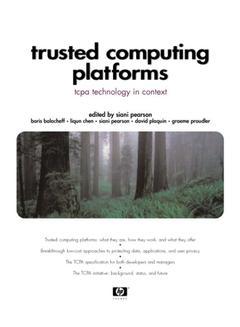Trusted computing platforms : TCPA technology in context
Auteurs : PEARSON Siani, BALACHEFF Boris, LIQUN Chen, PLAQUIN David, PROUDLER Graeme

An accessible introduction to a new industry standard that is a breakthrough in the field of computer security.
- Authoratitive information from founding members of the Trusted Computing Platform Alliance (TCPA) technical committee.
- TCPA founding members include HP, Microsoft, IBM, and Intel.
- Trusted Platforms explained, implications explored, and examples illustrated using a variety of scenarios relevant to everyday business usage, including applications to mobile devices.
Siani Pearson, Boris Balacheff, Liqun Chen, David Plaquin, and Graeme Proudler work in Hewlett Packard Labs Trusted Computing Platforms Group, which took part in the founding of the Trusted Computing Platform Alliance (TCPA). The HP group contributed some of the original ideas on which TCPA technology is based, have been members of the TCPA technical committee since its inception and have helped develop the TCPA specifications, in collaboration with engineers from across the industry. The authors have a background in information security and work in the HP Labs Trusted E-Services laboratory in Bristol, England.
(NOTE: Each chapter concludes with Summary.)
Preface.
Acknowledgments.
Disclaimer.
About the Authors.
I. INTRODUCING TRUSTED PLATFORM TECHNOLOGY.
1. Trusted (Computing) Platforms: An Overview.2. Usage Scenarios.
3. Key Components of Trusted Platform Technology.
II. TRUST MECHANISMS IN A TRUSTED PLATFORM.
4. Access Control-Ownership, Enabling, and Authorization.
5. Platform Identification and Certification.
6. Integrity Recording, Reporting, and Secure Boot.
7. Protected Storage.
8. Migration and Maintenance Mechanisms.
9. Conventional Security Functions and Assorted Host Functions.
III. TRUSTED PLATFORMS IN PRACTICE.
10. Bringing a Trusted Platform to Life.
11. Building Trust.
12. Challenging a Trusted Platform.
IV. TRUSTED PLATFORMS FOR ORGANIZATIONS AND INDIVIDUALS.
13. Corporate Deployment of Trusted Platforms.
14. The Trusted Platform in Front of You.
Appendix A: Brief History of TCPA.
Appendix B: Trust Models and the E-Commerce Domain.
Appendix C: Basic Cryptographic Primitives Used in the TCPA Specification.
Glossary.
References.
Index.
Date de parution : 09-2002
Ouvrage de 322 p.
18x24 cm


